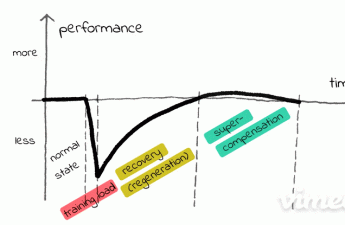The concept of regeneration based build-up training is founded on the recommendation to let each hard trained muscle part regenerate for a sufficiently long time before the next training impulse takes place. And also on the assumption that different muscles need different amounts of time for this. But what if this assumption is not true at all?
The basic idea: First repair, then build up
By now, word has spread: Hard and intensive build-up training causes tiny tears in the muscle fibers. Only after training can the body begin to repair this damage. And after the necessary repair, it is a matter of better equipping the body for such stresses: after regeneration, the build-up of strength and muscle mass begins. While these processes are taking place, the affected muscle should in any case still be spared – training too early could disrupt or even stop the desired rebuilding process that is just taking place.
Not necessarily felt
But when is the previously trained muscle ready to be trained again the next time? That is not easy to answer. The problem is that you can’t feel it. Sure – that you should not train again with a sore muscle yet, most people know that. But the absence of muscle soreness does not mean that the muscle is already sufficiently recovered: unfortunately, you can not clearly perceive at what point the regeneration and the subsequent phase of building are really completed.
Pause: Too long, too short?
The period after recovery, which is characterized by a slightly increased performance level, is often referred to as supercompensation: The trained muscle is thus a little bit stronger or bulkier than before.
If you want to optimize your training, you will try to place the next training stimulus in this phase of supercompensation. So: You should neither train the muscle too early (as long as the regeneration or repair is not yet completed), nor too late (after the increased performance level of supercompensation has already subsided). It is therefore a matter of hitting the phase of supercompensation with suitable exercises if possible.
Different recovery duration?
Well, that wouldn’t be such a big problem if every muscle in the body took the same amount of time to recover. However, as early as the early 1990s, the International Sports Sciences Association (ISSA) published a table showing that different muscles require different recovery times – depending, of course, on the intensity of the previous training. This duration ranges from 1 day (forearm, low intensity) to 5 days (lower back, high intensity) – quite a wide range.
On the one hand, it is interesting to note that these and similar tables can still be found in current trainer education documents. And on the other hand, the fact that these findings seem to flow extremely rarely into concrete training planning. Which is somehow also understandable: because depending on the previously trained exercises and their distribution of the working load on the different muscles, recovery also takes different lengths of time. The topic therefore quickly becomes quite complex and confusing.
But what if all this is not true at all?
However: A theory may sound so plausible, but it can still be wrong. And who wants to fall for an approach that doesn’t work in practice?
Well, let’s think about the way in which we could approach this. The following consideration seems helpful: What happens in the worst case if we train according to this theory, but it is not quite correct?
In this case, a varied training is to be expected, since the load situation of the muscles is always different. And always new combinations of the just again “mature” muscles probably lead to the inclusion of new exercises in the training program. The result: a high degree of flexibility in training planning.
And another essential point is getting used to regular training, which is fun: Always different, always new – but always based on the user’s own situation. The regeneration based build-up training knows only one standard: The previous training of the user, because this creates the basis of what should be trained next and when.
There is much to gain – and virtually nothing to lose
It is relatively clear to see: This approach offers some significant benefits without exposing the exerciser to any particular risks. So exploring this new path seems to be an exciting experiment without any serious dangers. It is therefore obvious to test the concept of regeneration based build-up training extensively yourself – and to check whether this new approach could be crucial for the success of your own training.



